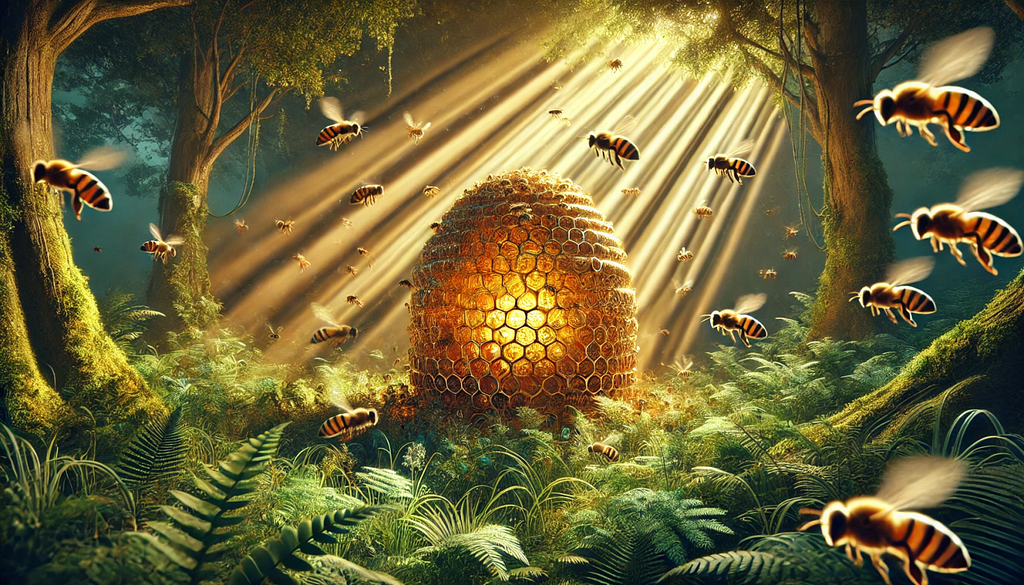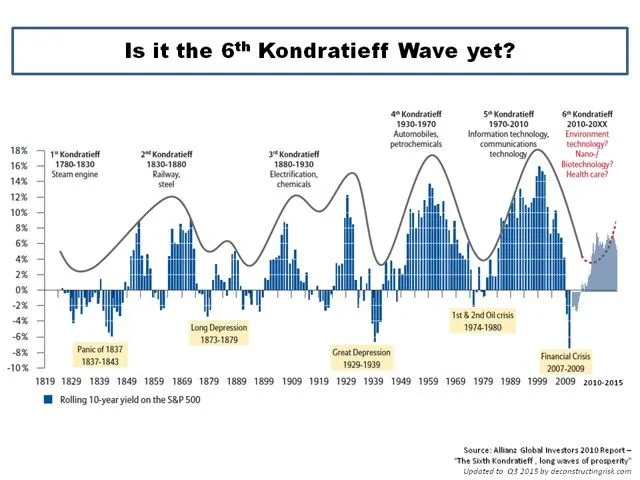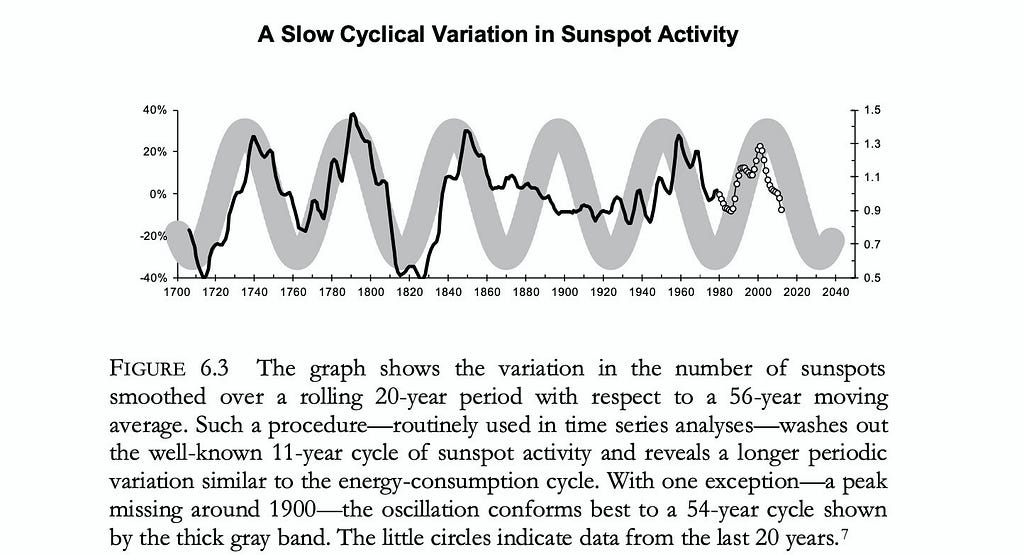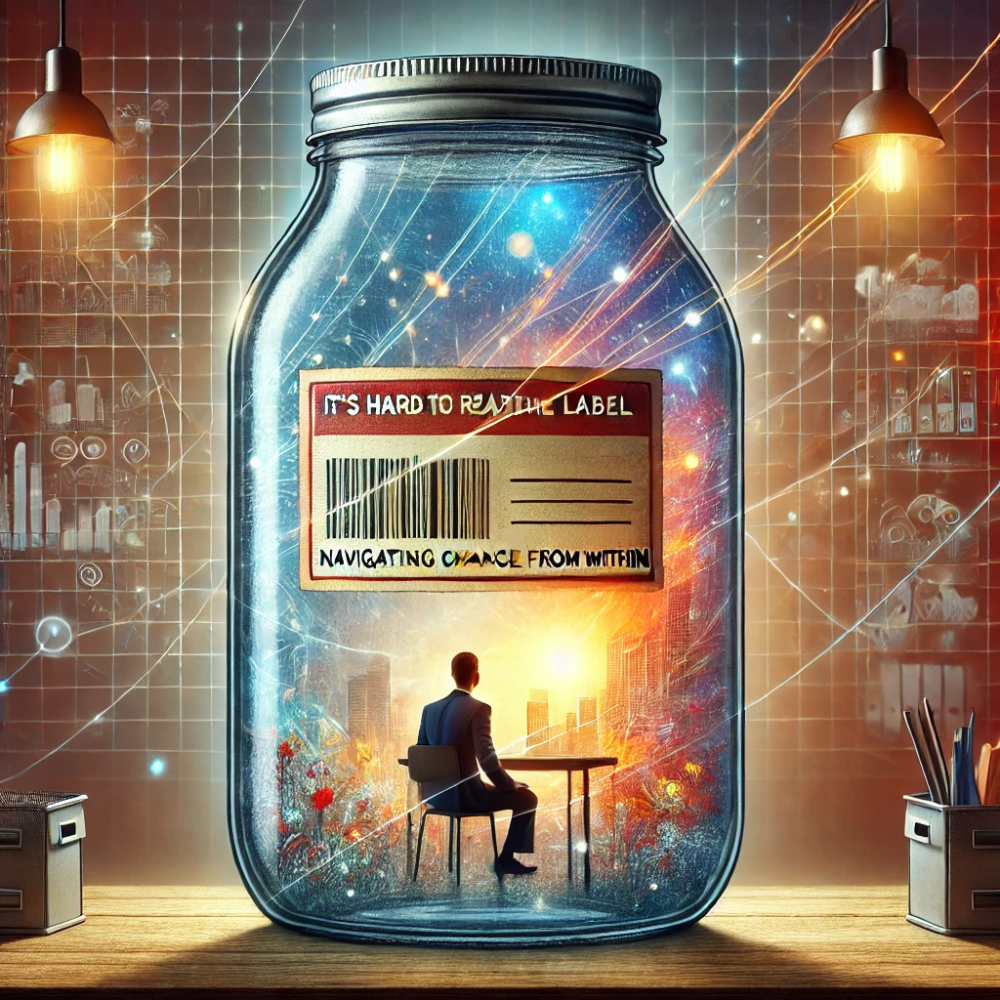[The Winner of “Energy Rising” by Julia DiGangi is Francisca C. Francisca we will be in touch to organize delivery. We also look forward to meeting you at The Reinvention Summit, tickets are still available at an early bird rate here. ]
TLDR: In our professional and personal lives, we often find ourselves immersed in our daily routines, working diligently to put out the next fire. However, amid our efforts, it’s easy to become so deeply entrenched in our tasks that we lose sight of the bigger picture. In this article, we explore the concept that “It’s Hard to Read the Label from Inside the Jar” and discuss the challenges and opportunities that arise when navigating change from within.
Watch of listen to this article here:
https://medium.com/media/fefc22e2ddf2d3336941818ffe254b8a/href
“Sea spray that forms when an ocean wave crashes serves as a good illustration of birth and death. A drop of spray that has become separated from the waves cannot experience oneness with the ocean or receive energy from it. The individual drop of spray thinks that it exists separately and has nothing in common with the ocean until such time as it falls back into the waters and its awareness of oneness is restored. At this point, the drop merges with the ocean into a single whole, for in essence they are made up of the same element–water.” — Vadim Zeland

This week’s lead quote beautifully encapsulates the human condition. Much like the drop of sea spray, we often see ourselves as isolated individuals, disconnected from the larger whole. But what if this perspective is flawed? What if we are not just individuals but integral parts of a much larger system, a collective whole, a superorganism? What does this have to do with Beehives, Kondratiev waves and Sony?
The Beehive as a Superorganism

Imagine a bee. It’s a tiny creature made up of countless living cells, each one an independent life form. Yet, these cells come together to create something greater: the bee itself, an individual with its own life. That bee is also part of a hive — a superorganism — where thousands of bees work together as a single, unified entity. The beehive is another animal. While it doesn’t look that way, it has many different properties. For instance, it’s a warm blooded creature. The hive holds its temperature at 97 degrees even though bees are cold blooded. It has a memory that’s years long, even though bees only live a few weeks, it reproduces at its level. It has a lifespan very different than the bees. The cells, the bee, and the colony all coexist, layered within one another, each unaware of the bigger picture.

Now, back to us. We, too, are made up of billions of living cells, each with its own life, working together to form the person we know as “you.” But just as a bee doesn’t grasp the full scope of its colony, we might be part of something even greater, something beyond our perception. This is what Byron Reese, in a recent episode of The Innovation Show, describes as “Agora.” What if we humans are like cells in a larger organism? Just as the hive is an organism, are we part of a collective superorganism beyond our understanding?
The challenge is that “it’s hard to read the label from inside the jar.” Just as a bee can’t comprehend the hive, we struggle to perceive the systems we’re embedded within. This metaphor captures a fundamental challenge we face in our personal and professional lives: the difficulty of gaining perspective when we’re deeply embedded in our day-to-day tasks. When working within the confines of your immediate responsibilities, it’s easy to lose sight of the bigger picture.

This is particularly true in the world of business, where the relentless focus on the firefighting of daily operations can obscure broader trends and strategic shifts. Just like a label on the inside of a jar is challenging to read, the changes in the business environment may elude us when we are too absorbed in our daily operations.
Kondratieff Cycles

“Life can only be understood backwards; but it must be lived forwards.” — Søren Kierkegaard
Kondratiev waves are long-term cycles in the economy, lasting around 50 to 60 years, driven by major technological breakthroughs or innovations. These waves have two phases: a boom, when new technologies like electricity, cars, or the internet create growth, jobs, and opportunities, and a bust, when their impact slows, industries mature, and economic challenges arise. Understanding these waves helps businesses anticipate the broader patterns of growth and decline, so they can adapt, innovate, and prepare for the next big opportunity. It’s about seeing the long-term rollercoaster of progress and planning for the ups and downs.

We discussed Kondratiev waves on our Innovation Show series with Theodore Modis and his work on S-Curves. Theodore applied the Kondratiev waves to sunspot activity. The graph above, from his book, “An S-Shaped Adventure”, illustrates a slow, cyclical variation in sunspot numbers over time, smoothed over a 56-year moving average. These long-term cycles, much like Kondratieff waves, reveal patterns that are often imperceptible when viewed through a short-term lens. Just as we need tools and models to detect sunspot cycles, we need similar frameworks to uncover the economic and organisational cycles shaping our world.

Sunspots and Kondratieff waves remind us that we’re often blind to the larger rhythms of our existence. Reading about this made me think. Imagine that our world goes through longer-term imperceptible cycles. Imagine our world has been at a similar point of maturity before. What if there have been many ice ages? What if the pyramids, Atlantis, and other sophisticated ruins are remnants of previous cycles of sophisticated life on Earth? These are patterns and cycles we can’t comprehend from within the jar.
Companies miss cycles all the time. Even the most innovative organisations get blinded by their fixation with life inside the jar, failing to see the broader rhythms shaping the world around them.
The Trap of the Inside View

This challenge of missing cycles is what Sven Smit calls “The Inside View.” When organisations rely solely on the inside view, they become trapped in their current perspective, focusing on what they know and understand while ignoring external trends and blind spots. This unchecked focus creates a false sense of certainty about the future. Decisions are often made as though the company is the only horse in the race, with little consideration for how competitors or external factors might shape the outcome.
The story of Sony is a prime example of how a company can rise to prominence by taking advantage of the inside view of others, only to fall victim to its own inside view years later. Sony’s transformation from an electric blanket company to a global leader in consumer electronics was fueled by its ability to exploit the blind spots of established competitors.
When Bell Laboratories invented the transistor in 1947, giants like RCA and GE failed to read the label and dismissed the new technology. They remained tethered to their investments in vacuum tube-based products. Akio Morita, Sony’s visionary CEO, recognised this opportunity and licensed the transistor technology, leading to the creation of the iconic transistor radio that revolutionised the market. Sony’s agility and willingness to embrace new technologies allowed it to outmanoeuvre its more entrenched rivals.
However, as Sony grew and matured, so too did the company’s inside view. Over time, the company’s focus shifted from innovation to protecting its existing business model, making it less adaptable to emerging trends. This inability to adapt became evident in the early 2000s when Sony failed to capitalise on the rise of digital music. Despite having all the components to dominate the MP3 player market — a strong brand, digital rights management technology, and a record label — internal conflicts and a reluctance to cannibalise its existing business model paralysed Sony. Meanwhile, Apple seized the opportunity with the iPod and iTunes, swiftly dominating the digital music landscape. Sony’s failure to act decisively, driven by its own entrenched processes and beliefs, allowed a new competitor to disrupt its long-held dominance.
The practices built up over decades of success can become the greatest adversary to future growth. Successful leaders must anticipate these challenges and confront their own ingrained processes and beliefs. The inside view can make even the greatest companies resistant to the changes that could ensure their survival and growth.
The best strategies are those that account for the risks you can’t see, not just the ones you can. Too often, organisations attribute good performance to superior management and blame poor performance on market conditions, failing to challenge their inside view. To avoid this, leaders must actively seek outside perspectives and embrace the discomfort of questioning long-held beliefs.
Escaping the Jar

“The hardest part of these decisions was neither the technological nor economic transformations required. It was changing the culture — the mindset and instincts of hundreds of thousands of people who had grown up in an undeniably successful company, but one that had for decades been immune to normal competitive and economic forces.”― Lou Gerstner Jr., Who Says Elephants Can’t Dance
The rise of solid-state electronics and the fall of Sony’s Walkman empire all underscore a fundamental truth: change is not merely about adopting new technologies or business models. It requires a fundamental shift in mental models–the deeply held beliefs and assumptions that underpin organisational behaviour.
This “jar effect” is pervasive in business. It is a driver of my passion to highlight what Mark Twain wrote, “History doesn’t repeat but it often rhymes.” Professionals, when we are deeply immersed in our specific roles, often fail to notice broader dynamics within their organisations or industries. This inadvertent tunnel vision can lead to missed opportunities or strategic missteps.
To overcome the limitations of the jar effect, we must actively seek ways to “read the label” from outside. This includes recognising that, much like Kondratieff cycles, our organisations and industries are subject to long-term rhythms of growth, stagnation, and reinvention. Identifying where we stand within these cycles can guide us in anticipating change rather than reacting to it.
Byron Reese’s theory of Agora invites us to consider the possibility that we are part of a superorganism, much like bees in a hive. Whether or not you believe that, the metaphor serves as a powerful reminder of the importance of perspective. The next time you feel overwhelmed by a crisis, remember you are just in a trough of a wave and there is a crest coming. The next time your business is enjoying a moment of success, remember that is the exact time to invest in the future. The next time you feel trapped by routine, remember: it’s hard to read the label from inside the jar, but stepping outside may reveal a world of possibilities.
Join us in reading the label and getting outside the jar in April in Dublin with a host of brilliant authors, speakers and change agents for the Davos for Doers, The Reinvention Summit. April 29th and 30th.
https://medium.com/media/f33d5e92ac608469bedd342b6ff024ca/href
Show episodes referenced above:
https://medium.com/media/ee01c8879f8e44e23a35384c2da04331/hrefhttps://medium.com/media/496da2b7d9bab43811aa0c1b38c1aa5c/hrefhttps://medium.com/media/f59b96092c1a4692cfb02b7d10ce48f6/href
It’s Hard to Read the Label from Inside the Jar: Navigating Change from Within was originally published in The Thursday Thought on Medium, where people are continuing the conversation by highlighting and responding to this story.